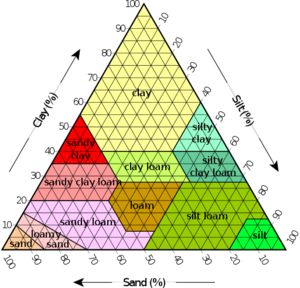Difference between revisions of "Sand"
| Line 13: | Line 13: | ||
==Soil Texture== | ==Soil Texture== | ||
[[File:USDA_Soil_Texture.png|right|thumb|Soil Texture Triangle]] | [[File:USDA_Soil_Texture.png|right|thumb|Soil Texture Triangle]] | ||
| − | Sand is an important component in many soils. It's one of the 3 | + | Sand is an important component in many soils. It's one of the 3 base components for soil according to the [[soil texture]] triangle, the others being [[silt]] and [[clay]]. These 3 combine in distinct ratios to make different soil types, like loam, silt loam, sandy clay, etc. |
==Ecology== | ==Ecology== | ||
Revision as of 17:47, 10 April 2021
Overview
Sand is a combination of broken-down grains of rock and minerals that forms from weathering. It may also contain biogenic material, like shells, coral, seaweed, or more. Grains smaller than sand are silt and grains larger are gravel. The word sand comes from the Proto-Germanic word sandam. [2]
Formation
Sand is the result of the breakdown of a variety of inorganic and organic materials. It is broken down via physical and chemical weathering. This could be from water, air, or other sand grains. It could be weathered chemically by minerals reacting with water, or other substances. Physical and chemical weathering tend to be a bit indistinguishable from each other when it comes to the formation of sand. [1] They support each other and occur at the same time. The older the grains, the smoother they are, young grains typically have sharper edges. [4]
Composition
Sand ranges in size from 1/16th to 2mm. [1] One of the most common possible materials is Quartz, although it can be composed of a large variety of minerals and materials. The most common tan beach sand is composed of quartz, some form of iron oxide (this reacts with oxygen to form red/tan material), feldspar, and other assorted rocks, minerals, or organic materials. [3]
Many different locations around the world are known for their distinctly colored sand, like pink sand from Utah, black sand from volcanic areas, green sand from Hawaii, etc. These unique sands all have compositional reasons for their specific color. For example, white sands often are largely composed of shells or skeletons of marine animals. Pink sands are often from single-celled organisms Homotrema rubrum, which posses red/pink shells. Green sands are often composed of Olivine, and black sands are often composed of volcanic rock. There are many other specific sands that have a very specific composition unique to them. [5]
Soil Texture
Sand is an important component in many soils. It's one of the 3 base components for soil according to the soil texture triangle, the others being silt and clay. These 3 combine in distinct ratios to make different soil types, like loam, silt loam, sandy clay, etc.
Ecology
References
[1] Sepp, Siim. "What is Sand" SandAtlas.org, Retrieved April 10, 2021, from https://www.sandatlas.org/sand/
[2] Harper, Douglas. “Sand.” Online Etymology Library, Etymonline.com, from www.etymonline.com/word/sand.
[3] NOAA. "How does sand form?" National Ocean Service, oceanservice.noaa.gov, from https://oceanservice.noaa.gov/facts/sand.html
[4] Adams, Dennis. "Beach Sand: What Is It, Where It Comes and How It Gets Here" Beaufort County Library, from https://web.archive.org/web/20091201183346/http://www.beaufortcountylibrary.org/htdocs-sirsi/beachsan.htm
[5] "Seaweed also plays a role in the formation of sand" Ocean Watch, from http://www.susanscott.net/Oceanwatch2002/mar1-02.html

